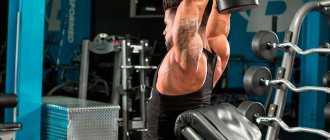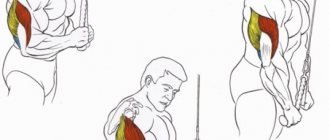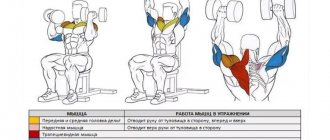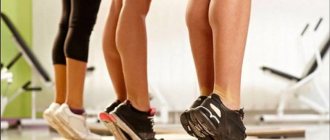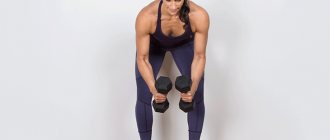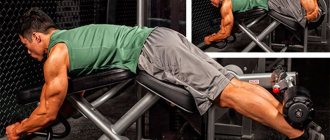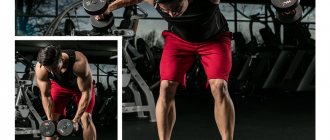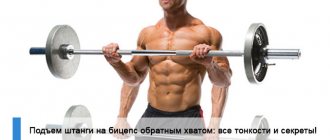Description
The overhead press is an effective exercise to include in your shoulder training routine.
What muscles work
The overhead press is a basic exercise. After performing this technique, the main load falls on the anterior and middle deltoid muscles. It would seem that when pressing behind the head, the rear delta is most loaded, but this is not entirely true, because the main load falls on the front head of the shoulder.
Benefit
The seated or standing overhead press has many benefits that benefit the athlete:
- increased tone;
- increase in muscle volume;
- working out the muscles of the shoulder girdle;
- independent performance without the support of a trainer;
- the exercise targets the triceps.
Contraindications
People who have various pathologies of the shoulder joints are contraindicated to perform the barbell press while standing from behind the head or while sitting. There is no need to risk your own health by trying to do the exercise. The bench press itself is considered dangerous, and the athlete can be injured even if the technique is performed correctly.
The weight should be selected correctly, since if it is large, the muscles that are responsible for holding the joints in the correct position may not be able to cope with such a load. As a result of this, the athlete will expect trouble in the form of a subluxation or dislocation. For this reason, if an athlete has problems with the shoulder joints, it would be better for him to refuse to perform this exercise.
Benefits of this exercise
By performing overhead extensions with dumbbells, we can safely count on a number of benefits
. Namely:
- Isolated triceps workout. In particular, the length of the head
- Improving the shape of the triceps muscle, making it more expressive and visually larger
- Makes elbow joints elastic
- Strengthening the shoulder muscles (due to static work)
- Possibility of unilateral training (each hand in turn). This helps to develop each arm evenly
- You don't need a lot of training equipment. What makes exercise more accessible?
If any of the benefits of this exercise match your training goals. Then feel free to take it into service. But I must warn you about one drawback.
- This exercise is very dangerous! In particular, for the shoulder and elbow joints.
But I’ll hasten to reassure you right away. If you followed the correct technique when doing dumbbell extensions from behind your head. And also exclude ambitions, and do not rush to take on a lot of weight. Then this drawback will not affect you.
Execution technique
The correct technique for performing a military press will allow you to get the maximum effect from your workout.
standing
Performing such an exercise is a difficult option and can only be done with a free barbell. There are several variations of the stance. In the first case, the legs should be shoulder-width apart and in line, and in the second, one leg is pushed forward and the other back to create a stable position.
Technique:
- Stabilize the body.
- Perform the press the required number of times.
- Lower the barbell onto your bent arms.
Sitting
Stages of preparation for bench press while sitting on a bench with a backrest:
- Place a bench with a backrest under the barbell racks.
- If necessary, adjust the height of the racks.
- The back of the bench should be at an angle of 75-80 degrees.
- After the preparatory steps, you will need to sit under the barbell so that it is located on the athlete’s back.
- Grasp the barbell with a medium grip so that your elbows are under it.
- Bend a little at the lower back.
- Rest your back against the back of the bench at the level of your shoulder blades.
Technique:
- After inhaling, hold your breath.
- Raise the barbell up. When performing the exercise, your elbows should be directed away from your body.
- Upon reaching the top point, the barbell should be lifted overhead with straight arms.
- The bar at the top point should be above the athlete's head.
- After a short pause, exhale.
- Using smooth movements, lower the barbell behind your head.
- Do not place the barbell on your shoulders until the end of the set.
In the Smith machine
The Smith Overhead Press is recommended for beginner athletes, as it is considered the safest option.
Technique:
- Set up a bench. As a result, the seat should be located under the bar of the simulator.
- Position the backrest perpendicularly.
- To provide support, raise the seat of the bench.
- You need to grab the bar wider than your shoulders so that your forearm is perpendicular to the floor.
- Rotate and lower the Smith bar behind the head.
- You need to lower the bar to the middle of your head or slightly below it.
- Press up without changing the angle of the forearm.
- Lower down, then perform the required number of repetitions.
Barbell overhead press in a seated position[edit | edit code]
The Seated Overhead Press requires more flexibility in the chest and shoulders than the Seated Overhead Press and has a more difficult starting position.
Brief description of the exercise
Raise the barbell above your head, then lower it behind your head at the base of your neck.
Stabilizing muscles
- Torso: Abdominal muscle group, erector spinae muscle.
- Shoulder joints: Rotator muscles.
- Shoulders: Serratus anterior, rhomboids, lower trapezius.
- Forearms: Wrist flexors.
Characteristics
- Combined/multi-joint
- Pressing
- Open circuit
- With a barbell
- Advanced level of fitness
Initial position
- Sitting, chest straightened, spine vertical.
- Grasp the barbell at shoulder width or slightly wider with an overhand grip.
Tips on proper exercise technique
:
- Warm up your muscles before starting the exercise. It is recommended that you use a mirror and the assistance of a training partner for insurance.
- Do not use inertial force; perform a slow, controlled movement through a full range of motion.
- Don't slouch or round your shoulders. Keep your chest open and your shoulder blades squeezed together.
- You must control your muscles by not leaning your head excessively forward and forcefully to lift the barbell at the beginning of the exercise.
- Exhale as you move up.
- Caution: Avoid performing this exercise if you have a history of shoulder dislocations.
| Motion Analysis | Joint 1 | Joint 2 | Joint 3 |
| Joints | Elbow | Brachial | Spatula |
| Directions of joint movements | Up - extension Down - flexion | Up - abduction Down - cast | Up - abduction up Down - bringing together and down |
| Mobilizing muscles | Triceps Elbow muscle | Deltoid | Serratus anterior muscle Trapezius muscle |
Basic mistakes
When bench pressing, athletes, due to inexperience, often make the following mistakes:
- Not performing preliminary warm-up exercises. Warm-up is very important, as it can prepare and warm up the shoulders, hands and elbows for working with the barbell. Ignoring it can cause dislocation or subluxation.
- Training with heavy weights. Wrong weight choice is always fraught with serious consequences.
- Cheating. To prevent injury when performing, it is not recommended to deviate from the correct technique, even in favor of more repetitions and working with heavier weights.
- Fixation at the top point. Fixation at the top point should not exceed more than a couple of seconds, since the axial load on the spine increases several times.
- Incorrect position of the bar. Quite a common mistake. When working, the projectile should be located on the chest or close to it and the collarbones.
- Wrong shoes. Training shoes are necessary to maintain balance when performing the approach. The best solution is to choose sneakers with a hard cushion without instep or heel.
Tips and tricks
If you adhere to the following tips, the athlete will be able to prevent injury when performing the exercise:
- The bar should be lowered as you inhale, and the chest should strive upward.
- You cannot swing your body while doing this.
- When performing it, it is important to monitor the position of your head and not throw the back of your head.
- When the athlete lifts the barbell, he must exhale.
- There is no need to change the trajectory of movement when performing the technique, and there is no need to throw your forearms back and forth.
- If you have any pain or discomfort in the joints, you should postpone training until you feel better.
- There is no need to use a wide grip, as it overloads the ligaments of the elbow joint, as well as the biceps, and causes discomfort.
- The optimal working weight should be selected.
- All movements should be smooth, and the pace of the exercise should not be fast, but rather slow.
- If the athlete is inexperienced, then hybrid variations of the exercise are not recommended for him, and he should not attach rubber to the bar.
- There is no need to perform bench presses with a curved bar.
Important Tips (Repetition is the Mother of Learning)
- Watch your breathing. EXHALE WITH EFFORT. Those. when going up - EXHALE, when going down - inhale.
- Don't go for heavy weights. Progression of the load, of course, must be present, because without it, muscle growth is impossible, but in this exercise, excessively large weights can injure your shoulder joints, so be careful.
- Gaze (head position) - straight forward. Down and up = impossible, because it immediately results in loss of balance. Therefore, it is best to perform the exercise in front of a mirror, looking at yourself forward. So everything will be ok, besides, it will allow you to see errors (if any) and correct them so that everything is okay.
- Use a grip (width) such that your forearms are vertical to the floor at the bottom.
- The bar must always be suspended. Those. placing the barbell on the trapezium at the lowest point (position) = under no circumstances is it possible, lowering occurs to ear level (lower is not necessary).
- At the top point of the movement (when you press the barbell up), do not extend your arms at the elbow joints to the end. Always leave a slight bend in the elbow joints. This will take the load off the triceps, and accordingly, they will not be able to steal the load from the deltas (shoulders). Because We train the deltoids with this exercise; it is important for us that the triceps are not included.
- While performing the exercise, your back should be straight (well, it is, just by the way), this point in this exercise is natural, your back itself will be straight. But, know that if you notice that you are leaning back or forward, you need to correct your technique, because this is unacceptable, your back must be strictly vertical (straight).
- Work in a controlled manner, smoothly, slowly, everything is under control: we squeeze the bar up - powerfully, with a faster movement, and down - relatively slowly, under control.
If you don't mind/feel sorry, please share the link to this article on social networks (social buttons are below). This is the best you can do, I will really, really appreciate it.
Best regards, administrator.
Thursday, July 18, 2019
Examples of ready-made complexes
For gaining muscle mass:
- Squats with a barbell - sets 5 to 10 times.
- Barbell rows to the chest while standing upright - 3 sets, 10 reps.
- Lunges using a barbell - 3 x 10 times.
- Bench press in a standing position from behind the head - 4 sets of 8 times.
- Crunches on an incline bench—3 x 10 times.
- Seated dumbbell press - number of sets 3, number of repetitions 10 times.
- Raising your arms with dumbbells to the sides, taking a standing position—3 x 10 times.
The rest time after performing each of the above exercises should be 1 minute 10 seconds.
For fat burning:
- Deadlift using dumbbells - requires 4 sets of 10 reps.
- Exercise in the leg lifting machine with elbow rests - 3 x 10 times.
- Performing rows on the lower block - number of approaches 4, number of repetitions 10.
- Lunges with dumbbells - 4 x 10 times.
- Exercise in a standing position: overhead press - 4 x 10 times.
- Wide push-ups - 3 sets, 14 reps.
- Leg straightening using a machine—3 sets, 10 reps.
- Exercise on an exercise bike - perform 1 set 10 times.
- Barbell curls for biceps - 4 sets of 10 reps.
With the exception of cycling, where you need to rest for 90 seconds, the rest time for other exercises is 1 minute.
